
What is this article about?
Educators interested in using video games for educational purposes should be aware of the considerable difficulties in developing a fun and engaging game, and take into account the user experience (UX). Game developers interested in education should understand the principles of learning, and the importance of transfer when creating an educational game.
Video games and education
Play is undoubtedly critical for a healthy development during childhood and infancy (1) and is beneficial for adults too (2). Children assimilate reality through play (3) and it remains the leading source of development for preschoolers (4). Therefore, the benefit of play, toys, and games to educate should be a given. With the appearance and explosion of video games, it is enticing to use this new medium to educate.
We have seen the interest of video game use for educational purposes growing the past two decades as the video game industry has exploded and now surpasses the movie industry as an entertainment activity. In 2015, video game industry revenues reached a whopping 22 billion in the U.S. alone, and 91 billion worldwide (for more information about sales, demographic, and usage data in the U.S., consult ESA’s Essential Facts 2016 report).
No wonder why everyone, from educators to politicians, wants to create their own video games. The idea of fostering the engaging power of video games for educational, health, or social goals, is highly exciting given that we now have examples of extremely successful games that can offer a great educational value, such as Minecraft, SimCity, or more recently Civilization.
The annual Games for Change Festival has just closed its latest chapter having celebrated its 13th year as a showcase for video games as a means to change education, health, and our world for the better. This festival is increasingly popular, and this year’s celebration highlighted some very encouraging projects, which got the audience rightfully excited. However, behind the shiny numbers and successful examples lies a hidden truth: making engaging video games is actually very hard.
Developing video games is hard
There are thousands of games out there and they can now be easily accessed with a click. The competition has become fierce and the video game industry is regularly hit with layoffs and closures earning it the nickname of the volatile industry. Promising AAA games fail — even those made by veteran teams with a huge development and marketing budget from established studios. Even established studios close (take Lionhead Studios and Avalanche Software as 2016 examples). On the independent developers’ side, it’s no better. Only a few games such as Minecraft become highly successful, inspiring us to follow the same path. However, no one hears about all the failures because, well, these games failed. In 2012, the crowd-funding platform Kickstarter released data suggesting that game projects are the ones with the lowest success rates on the platform. Moreover, among the successful campaigns, only about one third of the funded games had actually delivered a full product.
The game industry, which is in the business of manufacturing fun, often struggles to reach its goal. Commercial games are not necessarily fun. They can fail to engage or fail to retain their audience. Even video games that are considered successful can easily lose 20% of their audience after only one hour of play (see below the SteamSpy data from Warframe, a successful free-to-play game).

Just because we have some compelling examples of games that are highly engaging and fun to play doesn’t mean that all games are going to be fun or engaging, or even that it’s likely. It is actually very hard to achieve that level of engagement. In fact, big industry players have started to use cognitive science and data science to help them engage their audience and retain them, instead of relying on luck or gut feelings. This is how the User Experience discipline (UX) entered the industry.
Consider the User Experience when developing educational games
Popularized in the 1990s by Don Norman (5), UX has been around for decades within industrial design and web design. For the game industry, UX is a relatively fresh concept. In a nutshell, UX designates an umbrella discipline focused on evaluating and improving the experience of the end user of a product (such as a video game). Researchers and practitioners within this discipline examine how a person perceives and interacts with a system and the satisfaction and emotions elicited via this interaction (for more information about UX in games, see my Gamer’s Brain GDC presentation). This emphasis is important because a game is designed based on the designer’s mental model, then implemented in a system that has specific constraints. The players – coming with their expectations and prior knowledge – will develop a mental model of how they think the system works through their interaction with it (the designers are not shipped with the game). Therefore, the system image – that part of the game that the players can perceive and interact with – has to convey the experience intended. Note that UX is not about making the game easier. It is about removing the unwanted frustrations and making sure that your audience is going to experience the game the way game developers had intended.
To ensure that a game will be successful, studios are increasingly using a UX framework to guide them. A game UX framework considers the ease of use – usability – and the level of engagement – which I like to call gameflow. Usability (6) refers to how the user understands the system and interacts with it, taking into account human limits in perception, attention, and memory. Usability heuristics (7- 10) are guidelines that help identify and reduce the points of confusion or frustration that may occur when interacting with the game. Addressing usability entails considering concepts such as the clarity and consistency of the user interface, or the level of physical and cognitive load the game imposes on the players. The gameflow component considers if the game is enjoyable, engaging, immersive, and fun. It is inspired by psychologist Mihaly Csikszentmihalyi’s theory of flow (11) and was adapted to video games (12) and popularized by game designer Jenova Chen (13). Minding the gameflow is about making sure the game is never too easy or too hard,  so that it always offers the right level of challenge. Interestingly, this concept resembles Lev Vygotsky’s zone of proximal development (ZPD), which is the zone between that which the child can already do (too easy) and which she or he cannot yet accomplish (too hard). According to Vygotsky (14), play becomes a means by which to extend the ZPD; and we could argue that keeping the players in the flow zone, where the right level of challenge occurs, is the best way to have them motivated to overcome difficulties as well as learn new skills.
so that it always offers the right level of challenge. Interestingly, this concept resembles Lev Vygotsky’s zone of proximal development (ZPD), which is the zone between that which the child can already do (too easy) and which she or he cannot yet accomplish (too hard). According to Vygotsky (14), play becomes a means by which to extend the ZPD; and we could argue that keeping the players in the flow zone, where the right level of challenge occurs, is the best way to have them motivated to overcome difficulties as well as learn new skills.
Additionally, the gameflow considers the emotions elicited and is about ensuring player motivation. It also considers the learning curve so that all what is taught in the game has both context and meaning, as well as being distributed over time. In that regard, game UX is using the learning principles already well known by educators (such as behavioral psychology, cognitive psychology, and constructivist psychology principles).
Considering usability and gameflow heuristics as a checklist offers guidelines to accompany the game development. UX should be a concern of all the game developers on a team, although interaction designers, UX designers, or user researchers usually champion it. As soon as mock-ups or interactive prototypes are built (very early on in the development), the user researchers help the team test their designs with players unfamiliar with the game. Some studios have very fancy UX labs but UX testing can be conducted cheaply too. UX testing will allow developers to find many of the UX issues in a game earlier and faster, at a time when these issues can be readily, easily, and cheaply fixed (as opposed to when the testing is done too late in the development).
So if you have a great idea for an educational video game, you need to design the game with the target player’s experience in mind. If UX is a new concept to you, do not hesitate to partner with people who know about UX Design (or Human-Centered Design), Human Factors, or Human-Computer Interaction (HCI) to avoid common caveats and waste time fixing UX issues that could have been spotted earlier in the development of your game and corrected faster. The user experience intended for an educational video game being particularly critical (it has to both engage and teach the player the intended curriculum), it is even more important for educational projects to follow a UX framework.

Striving for a real educational experience and for skill transfer
In the past – and sadly still today – a lot of so-called educational games merely put some cute animations on a quiz. Because these games have been selling so far, there has not been a lot of effort put into their educational value, and we should carefully examine the learning outcome these games truly offer. Parents cannot easily tell which games or apps will really educate their kids. There is no label like the one we have for organic food that can guide the parents or teachers in their choice. Take the example of literacy skills. In their book Tap, Click, Read, Lisa Guernsey and Michael Levine (15) explain that the push for literacy is sometimes not driven by research on how language and literacy skills develop. Instead, educators and “educational games” are often relying too heavily on ABC and phonics drills that can sometimes be actually more harmful than truly educational. Too often, apps and games labeled as “educational” are making unsubstantiated or over-exaggerated claims. Educators and game developers alike need to understand child development and learning principles to reach a real educational value, then hope that their games will stand out from the plethora of mediocre educational games and apps out there, some of which are well-marketed and popular. So, you need to create a game with great UX and true educational value, and need to find a way to market it successfully (even if it is free).
A UX process and framework can help you achieve your educational goal because, ultimately, teaching educational content is not fundamentally different than teaching a game mechanic. For both, you need to start with the Why (i.e. Simon Sinek’s TED talk). The Why considers the purpose (16): in the case of an educational game, it’s about the learning goals for the designer (or educator) but also why this should matter for the players (the learner); why should they care. This Why should drive the How, the means to that purpose. This is where the educators should ask themselves what experience would meaningfully teach the concepts they want to teach. Maybe a video game is the most meaningful experience to accomplish that goal, maybe not. But if it is, then What mechanics and features the players will interact with is the next step to define. During the development of the game, the Why, the purpose, should drive everything else, from the pillars to the UX tests and iterative process, because developing a game is mostly about making choices, tradeoffs, and removing and prioritizing features. Considering the Why and the UX for it will help you stay on track.

One last hurdle to take into account is the question of transfer (see Fran Blumberg’s edited book Learning by Playing: Video Gaming in Education for more details; 17). Even if your educational game has great UX and great educational value, what the player will learn in the game will not necessarily transfer to new situations. However, transfer of learning – the extension of what was learned in one context to a new one – is the ultimate goal for educators. Consider a game with a true educational value like ST Math. This game, developed by MIND Research, is meaningful because it can claim some measurement of transferability onto State Math Test proficiency (if we accept that standardized academic tests measure what is important for children to learn). Another approach would be to design games in which the classroom curriculum has to be transferred into the game in order to overcome its challenges. Seymour Papert, mathematician and educator, had such approach as early as the 1960s. Inspired by Jean Piaget’s constructivist theory (18), Papert holds a constructionist approach to learning, by which learning is more efficient through discovery, when the curriculum is manipulated in contextual and meaningful situations. Instead of using computer games as means to teach the children, Papert (19) wanted the children to program the computer, using classroom knowledge, in meaningful goals they defined themselves. With help from colleagues and students at MIT,  Papert created the Logo computer language that allowed children to control a virtual turtle to accomplish certain goals, such as drawing a house for example. To draw a house, the children had to teach the turtle basic geometry, such as pivoting 90 degrees to draw a right angle, thereby transferring classroom knowledge to playful, contextual, and meaningful situations.
Papert created the Logo computer language that allowed children to control a virtual turtle to accomplish certain goals, such as drawing a house for example. To draw a house, the children had to teach the turtle basic geometry, such as pivoting 90 degrees to draw a right angle, thereby transferring classroom knowledge to playful, contextual, and meaningful situations.
As if developing a video game wasn’t hard enough, when you need players to learn something meaningful and transferable into new situations, you’re adding a meta-level of complexity that must be taken into account. It is easy to claim that games are fun and engaging. It is far more difficult to specifically assess how players truly experience the game, what they learned through their experience (20), and if what they have learned will transfer to new situations.
To conclude
A growing number of researchers and educators believe that video games have the potential to offer a meaningful experience in which children can progress at their own pace (21), adjusting their actions depending on the immediate feedback games offer. However, there are many hurdles that we will need to overcome before unleashing this potential and we are barely scratching the surface. We will overcome these challenges by understanding better about user experience and about learning principles, including transfer. The good news is that this should not discourage us to try, because only a careful iterative design process – at the foundation of any UX framework – will help us get there.
References
(1) Pellegrini, A.D., Dupuis, D., & Smith, P.K. (2007). Play in evolution and development. Developmental Review, 27, 261-276.
(2) Brown, S. & Vaughan, C. (2009). Play: How it Shapes the Brain, Opens the Imagination, and Invigorates the Soul. New York: Penguin.
(3) Piaget, J. & Inhelder, B. (1969). The Psychology Of The Child. New York: Basic Books.
(4) Vygotsky, L.S. (1967). Play And Its Role in The Mental Development of The Child. Soviet Psychology, 5, 6-18.
(5) Norman DA, Miller J, Henderson A. What You See, Some of What’s in the Future, And How We Go About Doing It: HI at Apple Computer. Proceedings of CHI 1995, Denver, Colorado, USA.
(6) Isbister, K. & Schaffer, N. (2008). What is Usability and Why Should I care?; Introduction. In K. Ibister & N. Schaffer (Eds.) Game Usability. Burlington: Elsevier.
(7) Nielsen J. Heuristic evaluation. In: Nielsen J, Molich RL. (Eds.) Usability Inspection Methods. New York: John Wiley & Sons; 1994.
(8) Desurvire H, Caplan M, Toth JA. Using Heuristics to Evaluate the Playability of Games. Extended Abstracts CHI 2004, 1509-1512.
(9) Laitinen S. Usability and Playability Expert Evaluation. In Ibister K, Schaffer N (Eds.) Game Usability. Burlington: Elsevier; 2008.
(10) Pinelle D, Wong N, Stach T. Heuristic evaluation for games: usability principles for video game design. In Proceeding of the Twenty-Sixth Annual SIGCHI Conference on Human Factors in Computing Systems (Florence, Italy, April 05 – 10, 2008). CHI ’08. ACM, New York, NY, 1453-1462.
(11) Csikszentmihalyi M. Flow: The Psychology of Optimal Experience. Harper Perennial, 1990.
(12) Sweetser P, Wyeth P. GameFlow: A Model for Evaluating Player Enjoyment in Games. ACM Computers in Entertainment 2005; 3: 1-24.
(13) Chen J. Flow in Games (and Everything Else). Commun ACM 2007; 50: 31-34.
(14) Vygotsky, L.S. (1978). Interaction between learning and development. In M. Cole, V. John-Steiner, S. Scribner & E. Souberman (Eds.) Mind in Society: The Development of Higher Psychological Processes (pp. 79-91). Cambridge, MA: Harvard University Press.
(15) Guernsey, L. & Levine, M. (2015). Tap, Click, Read: Growing Readers in a World of Screens. San Francisco, CA: Jossey-Bass.
(16) Sinek, S. (2009). Start With Why: How Great Leaders Inspire Everyone to Take Action. Penguin Group, New York, NY.
(17) Blumberg FC (Ed.). Learning by playing: Video Gaming in Education. Oxford University Press; 2014
(18) Piaget, J. (1937). La construction du reel chez l’enfant. Neuchâtel: Delachaux & Niestlé.
(19) Papert, S. (1980). Mindstorms. Children, Computers, and Powerful Ideas. New York: Basic Books.
(20) Meyer, R.E. (2014). Computer Games for Learning: An Evidence-Based Approach. MIT Press.
(21) Shaffer, D.W., Squire, K.R., Halverson, R. & Gee, J.P. (2005). Video games and the future of learning. Phi Delta Kappan, 87, 104-111
